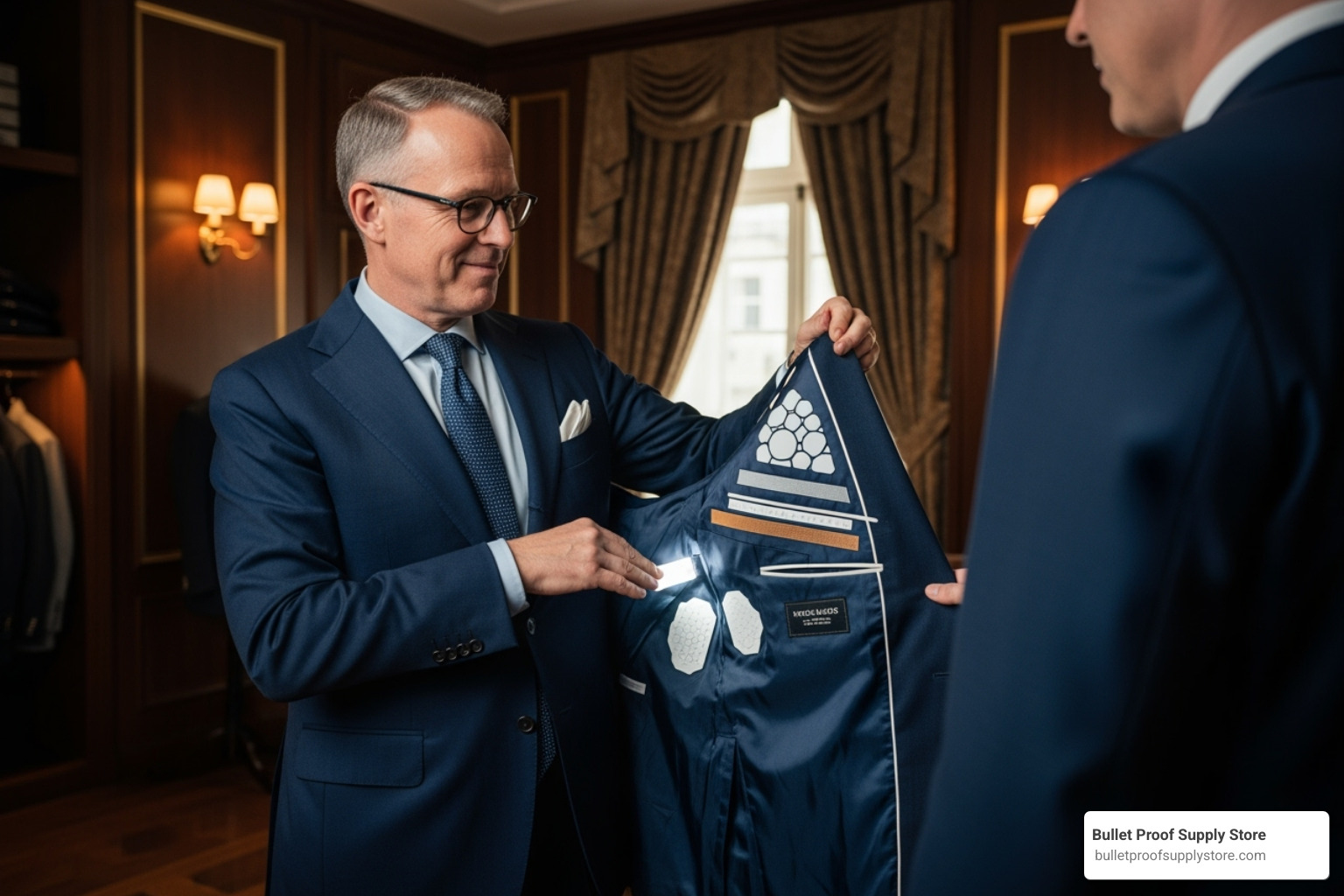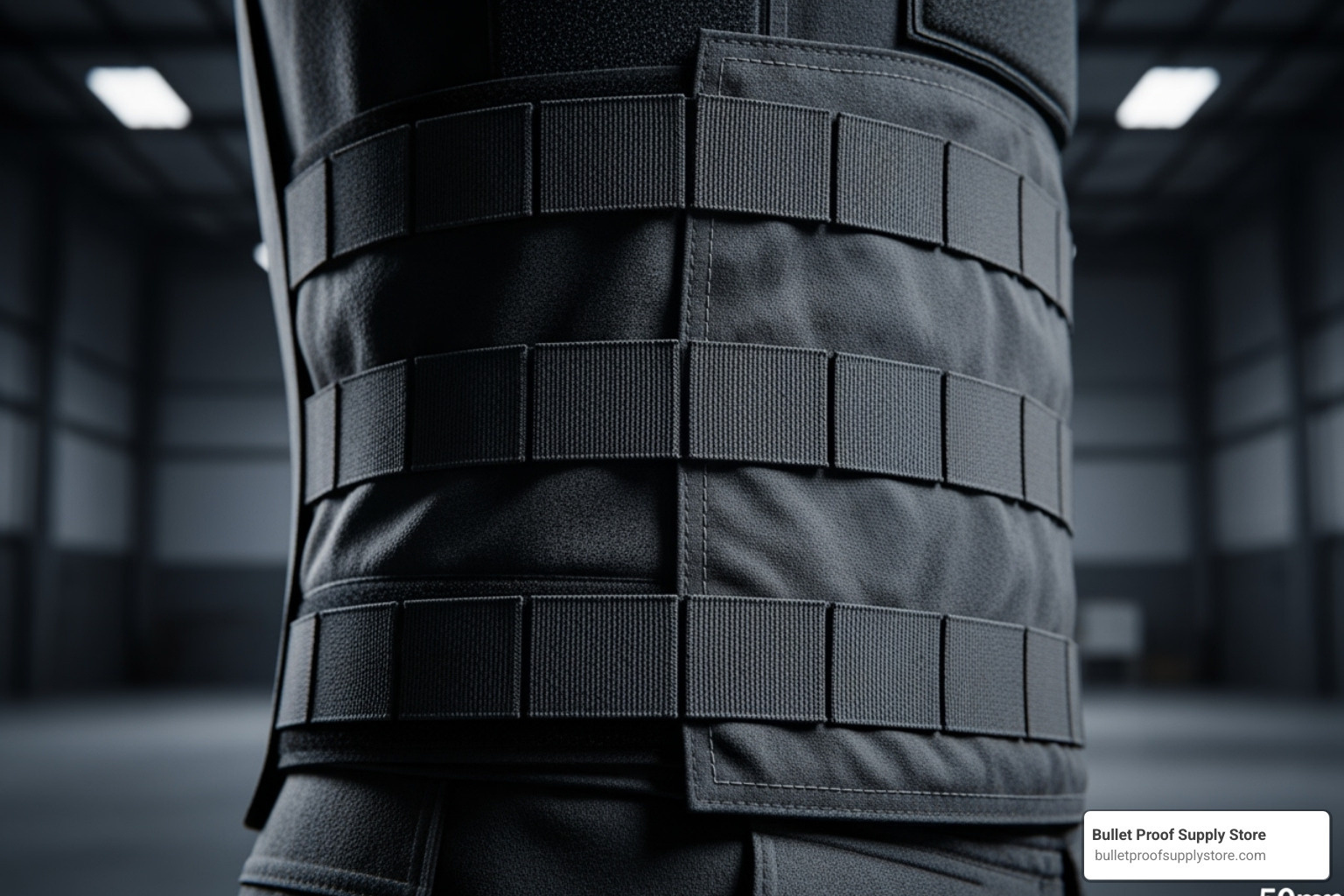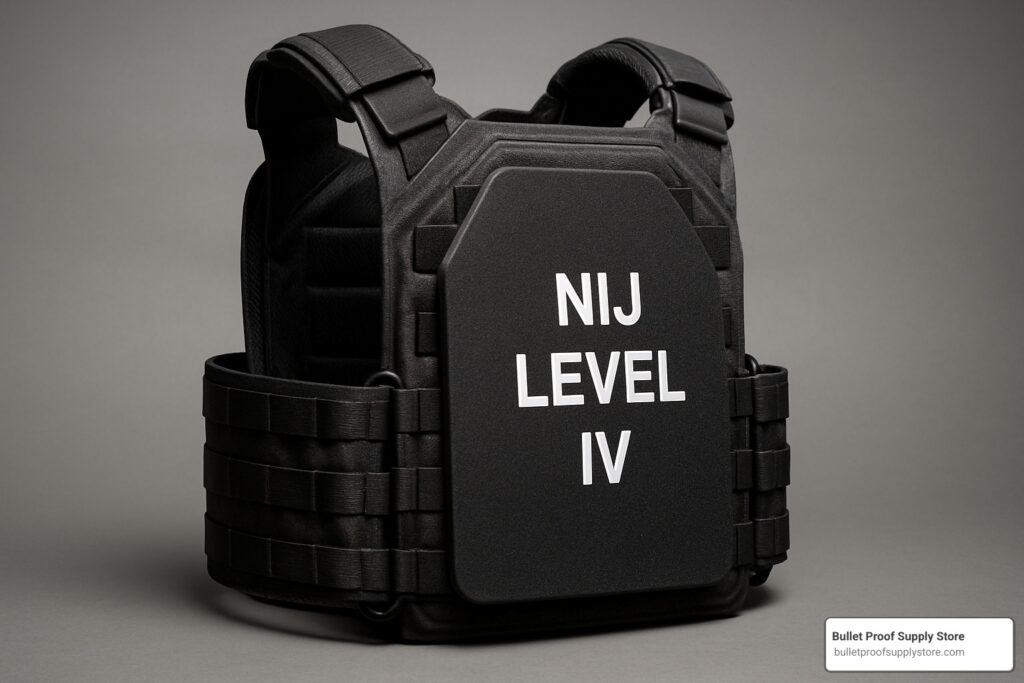Why John Wick’s Bulletproof Suit Captures Our Imagination
How real is the john wick bulletproof suit that allows Keanu Reeves to walk through gunfights with style and confidence? The short answer is that while real bullet-resistant suits exist, they’re nowhere near as effective or comfortable as the movie version suggests.
Quick Reality Check:
- Fiction: John Wick’s suit stops bullets with zero visible impact or injury
- Reality: Real bullet-resistant suits can stop handgun rounds but cause significant blunt force trauma
- Fiction: Thin, flexible fabric that doesn’t restrict movement
- Reality: Multiple layers of Kevlar and composite materials that add bulk and weight
- Fiction: Protects against all threats including knives and high-caliber rounds
- Reality: Most suits only protect against specific handgun calibers (NIJ Level IIIA)
The bulletproof suits in John Wick are described as containing “Silicon carbide discs. Ceramic matrices… kevlar sheets” sewn between fabric and lining, offering “zero penetration” according to the Continental’s tailor. While this sounds impressive, the physics of real ballistic protection tell a very different story.
Real bullet-resistant suits do exist—some companies and high-end tailors have created functional prototypes costing nearly $100,000, using advanced materials. However, these real-world versions come with significant limitations that Hollywood conveniently ignores.
After more than 15 years of testing and evaluating ballistic gear, seasoned armor specialists will tell you that understanding how real is the john wick bulletproof suit requires separating movie magic from the laws of physics. Field experience shows that even the best protection involves trade-offs that would make John Wick’s acrobatic gunfights impossible in real life.

The “Tactical Lining”: Deconstructing the Suit in the John Wick Universe
The magic happens in that memorable tailor scene from John Wick: Chapter 2. The Continental’s tailor proudly shows off the suit’s “tactical lining” – a sophisticated blend of silicon carbide discs, ceramic matrices, and Kevlar sheets all seamlessly woven between the fabric and lining. It’s this fictional combination of cutting-edge materials and masterful tailoring that gives the suit its almost supernatural abilities.

In the John Wick universe, this isn’t just protective gear – it’s standard issue equipment for High Table assassins. The suit allows these skilled killers to engage in intense gunfights in crowded public spaces while maintaining their cover. When you’re wondering how real is the john wick bulletproof suit, it’s worth noting that the movie version can absorb direct hits from handgun rounds while keeping the wearer mobile and combat-ready.
The on-screen performance is impressive. We watch John Wick take multiple hits to the torso, grimace from the impact, adjust his tie, and keep fighting. The suit’s ability to stop handgun rounds while absorbing most of the impact energy makes the film’s signature “gun-fu” choreography possible.
Fictional Strengths and In-Universe Rules
What makes the John Wick suit so appealing is how it solves the classic superhero problem: how do you stay protected without looking like you’re wearing armor? The suit’s neat appearance and concealed protection are game-changers. Assassins can attend high-society galas, blend into corporate boardrooms, and walk through hotel lobbies without raising suspicion.
The tactical advantage is clear throughout the films. While the tailor warns that impacts will be “quite painful,” the promise of “zero penetration” means our heroes can take calculated risks that would be impossible otherwise. This confidence boost transforms how characters approach dangerous situations.
For High Table assassins, the suit isn’t just protection – it’s a uniform that signals their elite status. The combination of style and invulnerability allows for the aggressive, up-close combat style that defines the franchise. Without this gear, the intense face-to-face gunfights that make John Wick movies so thrilling simply wouldn’t be possible.
The Suit’s Achilles’ Heel: Fictional Weaknesses
Even movie magic has limits, and the John Wick suit comes with some significant vulnerabilities. The most obvious weakness is blunt force trauma. While the suit stops bullets from penetrating, all that kinetic energy has to go somewhere. Characters still feel the impact and show visible pain when hit.
Stabbing weapons pose another serious threat. Throughout the films, we see knives penetrate the suits with relative ease. The ballistic protection that works so well against bullets offers little defense against sharp, pointed weapons that can slip between the protective elements.
The suit also struggles with high-caliber rounds. While it handles standard handgun ammunition well, rifle rounds and other high-velocity projectiles can overwhelm the protection. Sustained gunfire can eventually break down the suit’s defenses, leading to penetration or complete failure.
Perhaps most surprisingly, low-velocity projectiles like arrows can be effective against the suit. The films show characters being injured by arrows that embed themselves despite hitting the ballistic lining. This reflects real-world armor limitations where protection designed for high-velocity impacts doesn’t always work against slower, heavier projectiles.
These fictional weaknesses actually make the John Wick suit more believable. By acknowledging that even advanced protective gear has limits, the films maintain some connection to reality while still delivering the action sequences we love.
How Real is the John Wick Bulletproof Suit: Fiction vs. The Laws of Physics
Here’s where things get interesting. When we ask how real is the john wick bulletproof suit, we need to strip away the movie magic and look at what actually happens when bullets meet body armor.
First, let’s clear up some terminology. In the real world, we don’t really use the term “bulletproof” – it’s more accurate to say “bullet-resistant.” Why? Because no armor is truly impervious to everything. Even the best protection has its limits, and understanding those limits could save your life.

The John Wick films do what Hollywood does best – they make the impossible look effortless. But physics doesn’t care about good cinematography. When a bullet hits body armor, all that kinetic energy has to go somewhere. Newton’s laws are pretty clear on this: energy can’t just disappear.
In the movies, John takes a hit, winces slightly, and keeps fighting. In reality? That energy transfer is going straight into your body, and it’s not pleasant.
The Unseen Injury: Blunt Force Trauma
Here’s what the movies don’t show you: getting shot while wearing body armor is often described as feeling like being “hit with a hammer.” I’ve talked to countless law enforcement officers and military personnel who’ve taken rounds to their vests. They survived, absolutely, but they weren’t doing any fancy gun-fu afterward.
The impact can cause severe bruising, broken ribs, and even damage to internal organs. This happens because of something called backface deformation – when the armor flexes inward from the impact, it creates a significant concussive force against your body. The force can feel like being punched by a heavyweight boxer, leaving you stunned, disoriented, and struggling to breathe. You might survive, but you’re definitely not immediately resuming complex acrobatic maneuvers.
This is the reality of ballistic protection: it’s about survival versus comfort. The armor does its job by stopping penetration, but your body still absorbs a tremendous amount of energy.
Flexibility and Weight: The Realism Trade-Off
Watch John Wick glide through his fight scenes with that incredible agility. Notice how his suit never seems to restrict his movement? That’s pure movie flexibility at work, and it’s one of the biggest departures from reality.
Real bullet-resistant suits are inherently bulky and heavy. To stop bullets, you need multiple layers of specialized materials. We’re talking about suits that might use 16 layers of composite materials in the vest alone, with even more layers in the jacket. Each layer might be thin, but they add up quickly.
This creates significant weight limitations and impaired agility. Imagine trying to perform John Wick’s intricate combat moves while wearing what essentially amounts to a heavy, multi-layered blanket wrapped around your torso. It’s not happening.
The trade-off is unavoidable: the more protection you want, the more bulk you have to accept. Higher-level armor designed for rifle rounds would make you move like a tank with a broken engine – protective, sure, but definitely not suited for high-speed acrobatics.
This is the fundamental challenge in the world of bulletproof clothing: balancing protection with mobility. John Wick’s suit gives him the best of both worlds, but that’s the magic of Hollywood, not the reality of ballistic protection.
The Science and Craft of Real-World Bullet-Resistant Suits

Creating a bulletproof suit that actually works in real life is like trying to solve a puzzle where every piece fights against the others. You want something that’s lightweight, flexible, stylish, and protective – but physics has other ideas. The engineering challenges are immense, involving cutting-edge material science that pushes the boundaries of what’s possible.
While pop culture inspiration from movies like John Wick might make it look easy, replicating fiction in the real world is a completely different beast. The good news? Advancements in material science are constantly creating new possibilities, leading to what we call “the new generation of bulletproof clothing” that’s increasingly lighter and more flexible than ever before.
What Real Bullet-Resistant Clothing is Made Of
When you’re wondering how real is the john wick bulletproof suit, you need to understand what goes into actual bullet-resistant clothing. It’s not magic – it’s sophisticated materials designed to catch bullets and spread their energy across a wide area, like a spider web catching a fly.
The backbone of most bulletproof clothing is aramid fibers. This synthetic fiber has an incredible strength-to-weight ratio that makes it perfect for stopping bullets. These fibers get woven into dense mats that can absorb tremendous amounts of energy.
Another is called Ultra-High-Molecular-Weight Polyethylene. These materials are incredibly strong and lightweight, making them ideal for modern ballistic protection. They’re thermoplastic, which means they can be molded and shaped more easily than traditional fibers.
The cutting edge of bulletproof materials involves carbon nanotubes. These advanced materials are being explored for their potential to create even lighter and more flexible ballistic fabrics. Some high-end custom suit makers claim to use nanotechnology that makes their material 50% lighter than traditional Kevlar.
Most bulletproof clothing uses what we call soft armor – layers of these materials woven together. For higher levels of protection, especially against rifle rounds, you need hard plates made of ceramic or metal. But for a suit that looks normal? You’re limited to soft armor options.
Understanding Ballistic Protection: NIJ Levels Explained
Here’s where things get technical, but it’s crucial for understanding what real bulletproof suits can and can’t do. The NIJ standards (National Institute of Justice) set the rules for how we measure ballistic protection. Think of them as report cards for body armor.
Level IIA protects against 9mm and .40 S&W rounds – basic handgun protection. Level II steps it up to handle 9mm and .357 Magnum rounds. Level IIIA is where most real-world bullet-resistant suits aim to be. This is the highest level of protection you can get with soft armor alone, stopping .357 SIG FMJ and .44 Magnum SJHP rounds, plus most common handgun rounds like 9mm, .45, and hollow points.
When you move up to Level III, you’re talking about rifle protection, specifically 7.62mm FMJ-BT (M80 ball). This requires hard plates, which makes a normal-looking suit impossible. Level IV is the highest level, protecting against armor-piercing rifle rounds like .30-06 Springfield M2 AP. Again, this needs hard plates.
The testing protocols for these levels are rigorous. Each piece of armor gets shot multiple times with specific ammunition at specific velocities. The NIJ Level IIIA protection that most bulletproof suits achieve is impressive, but it’s important to understand the limitations.
Real-Life “John Wick” Suits: The Possibilities
Despite all the challenges, some innovative projects have actually created functional bullet-resistant suits that work in real life. These aren’t just concepts – they’re actual suits that have undergone ballistic testing and can stop common handgun rounds.
For example, some projects have resulted in functional suits capable of stopping handgun rounds like .357 Magnum, .45 ACP FM, 9mm FM, and even 12-gauge rifled slugs. The high cost can be staggering, with some prototypes costing nearly $100,000 to produce. That’s serious bespoke tailoring money, but it shows what’s possible when money is no object.
In some cases, a waistcoat might pack 16 layers of composite materials while staying just 3.4 mm thick, and a jacket could contain 20 layers of special Kevlar. This demonstrates that discreet protection is achievable, but it comes with trade-offs that movie suits conveniently ignore.
Some high-end tailors now offer custom bullet-resistant suits using advanced materials like carbon nanotubes, which they claim are 50% lighter than traditional Kevlar. These suits cater to high-profile clients who need protection without looking like they’re wearing armor.
But here’s the reality check: even these impressive real-world suits have limitations compared to movie versions. They’re primarily designed for handgun protection (NIJ Level IIIA), not rifle rounds. They add weight and some bulk, no matter how well-engineered they are. Most importantly, while they prevent penetration, they don’t eliminate the blunt force trauma that comes with getting shot.
So while you can get a highly effective, stylish bulletproof suit in real life, it won’t give you John Wick’s ability to shrug off bullets and keep fighting like nothing happened. Physics still wins in the end.
Frequently Asked Questions about John Wick’s Suit and Real Body Armor
So, how real is the John Wick bulletproof suit, ultimately?
The John Wick bulletproof suit as we see it on screen is pure movie magic – a brilliant piece of fictional storytelling that combines style with seemingly impossible invulnerability. While it’s inspired by real ballistic technology using materials like Kevlar and ceramics, the suit’s ability to completely absorb impact without causing injury is firmly in the field of fantasy.
In reality, even the most advanced bullet-resistant clothing comes with serious limitations. When a bullet hits real body armor, that energy doesn’t just disappear – it transfers into your body, causing significant blunt force trauma. You might survive, but you’ll definitely feel like you’ve been hit by a truck.
The movie version allows John Wick to shrug off direct hits and continue his acrobatic fight sequences without missing a beat. Real ballistic protection simply doesn’t work that way. It’s designed as a survival tool, not an invincibility cloak. The accurate term is “bullet-resistant,” not “bulletproof” – a crucial distinction that reflects the real-world limitations of even the best protective gear.
It’s also worth noting that most bullet-resistant suits don’t protect against knives or stabbing weapons. For that level of protection, you’d need specialized multi-threat armor, which adds even more bulk and weight. You can learn more about this important distinction by exploring Bulletproof vs. Stabproof Vests.
Can you buy a real bulletproof suit?
Yes, you absolutely can purchase a real bullet-resistant suit, though it comes with some important caveats. These aren’t items you’ll find hanging in your local department store – they’re custom-fitted, high-end protective garments that typically offer NIJ Level IIIA protection against common handgun rounds.
The cost is substantial. As mentioned earlier, some prototypes have cost nearly $100,000 to produce. While you might find more affordable options in the thousands rather than tens of thousands, they still represent a significant investment. These suits are primarily designed for high-profile individuals who need discreet protection – think executives, politicians, or anyone whose work puts them at risk.
The reality is that these real-world suits are bulkier and heavier than John Wick’s seamless garment. They’ll protect you from most handgun threats, but they won’t make you invincible. High-caliber rifle rounds and sustained gunfire can still overwhelm the protection. Plus, you’ll still experience that painful energy transfer we talked about earlier.
For those looking for more accessible protection, companies like this offer custom bullet-resistant dress suits for adults that provide excellent NIJ Level IIIA protection without the Hollywood price tag.
What’s the most important takeaway about how real is the John Wick bulletproof suit?
The most crucial point about how real is the john wick bulletproof suit is understanding what real ballistic protection actually does – and what it doesn’t do. Real body armor is designed to stop penetration, which means keeping the bullet from entering your body. That’s its primary job, and it does it well.
However, stopping a bullet doesn’t mean stopping the significant energy transfer that comes with it. Even when the bullet doesn’t penetrate, you’re still going to experience substantial blunt force injury. Think bruising, potential broken ribs, and the very real possibility of internal damage. It’s the difference between surviving an attack and walking away unscathed.
This is why we emphasize that real ballistic protection is a survival tool – it dramatically increases your chances of living through a violent encounter, but it won’t let you continue fighting like nothing happened. Understanding these limitations is essential for anyone considering body armor, whether it’s a high-end custom suit or more practical everyday protection.
For a deeper understanding of how real ballistic protection is tested and certified, check out Understanding Bulletproof Vest Testing: NIJ Standards Decoded. This knowledge helps you make informed decisions about your personal protection needs.
Conclusion: Dressing for Safety in the Real World
The John Wick suit represents the perfect fantasy – a seamless blend of high fashion and impenetrable armor that lets our favorite assassin walk through gunfights looking like he stepped off a magazine cover. It’s movie magic at its finest, allowing us to suspend disbelief and enjoy cinematic action where heroes can absorb bullets and keep fighting with barely a wince.
But when we dig into how real is the john wick bulletproof suit, we find a fascinating world where reality and fiction intersect in unexpected ways. Real bullet-resistant clothing absolutely exists, and it’s a testament to incredible advancements in material science and engineering. Companies are creating suits that can genuinely stop handgun rounds while maintaining a professional appearance.
However, these real-world marvels operate within the unforgiving constraints of physics. They’re designed to save lives by preventing bullet penetration, but they can’t eliminate the significant blunt trauma that comes with absorbing a bullet’s kinetic energy. Understanding these limitations – particularly the NIJ levels of protection – is crucial for anyone considering real ballistic gear.
The truth is, getting shot while wearing even the best bullet-resistant suit would leave you bruised, possibly with broken ribs, and definitely not ready to continue an acrobatic gunfight. Real protection is about survival, not invincibility.
At Bullet Proof Supply Store, we believe in providing accessible safety without breaking the bank. We understand that while you might not need to survive High Table assassins, personal protection is still important in today’s world. That’s why we source directly from manufacturers to offer top-tier NIJ Level IIIA protection at prices that won’t empty your wallet.
Whether you’re looking for a discreet Bulletproof Hoodie Level 3A With Hood Panels or other forms of personal ballistic protection, we’re committed to ensuring you have practical, life-saving gear. While our products won’t turn you into John Wick, they will provide you with reliable protection that’s been rigorously tested to real-world standards.
Explore our collection of high-quality, tested body armor and protective vests and find how modern ballistic protection can fit into your everyday life – no Continental Hotel membership required.



